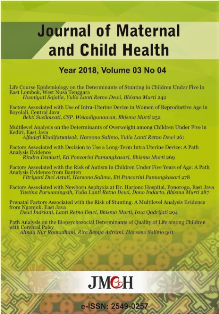Multilevel Analysis on the Determinants of Overweight among Children Under Five in Kediri, East Java
Abstract
Background: Child overweight and obesity are an important public health issue worldwide. Overweight and obese children are likely to stay obese into adulthood and more likely to develop non-communicable diseases like diabetes and cardiovascular diseases. This study aimed to determine factors associated with overweight among children under five in Kediri, East Java, using a multilevel analysis model.
Subjects and Method: This was a case control study conducted at 25 posyandus (integrated family health posts) in Kediri, East Java, from April to May 2018. A sample of 200 children under five was selected by fixed disease sampling. Posyandu was selected by stratified random sampling. Children were located at level 1 and posyandu at level 2 in the multilevel analysis model. The dependent variable was overweight. The independent variables were maternal body mass index (BMI), exclusive breastfeeding, calorie intake, feeding pattern, and nutritional status monitoring. Overweight status was measured by weight for height z-score. The data were collected by questionnaire and analyzed by a multilevel logistic regression model run in Stata 13.
Results: Maternal BMI ?25 (b= 0.72; 95% CI= -0.98 to 1.54; p= 0.085) and calorie intake exceeding the recommended allowance (b= 1.45; 95% CI= 0.59 to 2.31; p= 0.001) increased the risk of overweight in children under five. Good feeding pattern (b= -1.11; 95% CI= -2.15 to -0.08; p= 0.034), exclusive breastfeeding (b= -0.97; 95% CI= -1.98 to 0.02; p= 0.057), and regular nutritional status monitoring (b= -4.34; 95% CI= -6.42 to -2.21; p<0.001) decreased the risk of overweight. Posyandu showed negligible contextual effect on the incidence of child overweight with ICC= 0.98%.
Conclusion: Maternal BMI ?25 and calorie intake exceeding the recommended allowance increase the risk of overweight in children under five. Good feeding pattern, exclusive breastfeeding, and regular nutritional status monitoring decrease the risk of overweight in children under five. Posyandu has a negligible contextual effect on child overweight.
Keywords: overweight, children under five, exclusive breastfeeding, maternal body mass index, multilevel analysis
Correspondence:
References
Badan Penelitian dan Pengembangan Kesehatan Kementrian Kesehatan RI (2014). Laporan Hasil Riset Kesehatan Dasar 2013. Jakarta: Departemen Kesehatan Republik Indonesia.
Black J, Black JA, Park M, Gregson J, Falconer CI, White B, Kessel AS, Kinra S (2015). Child obesity cutoffs as derived from parental perceptions. Br J Gen Pract. 65 (633): e234-e239. doi: 10.3399/bjgp15X684385.
Demir D, Bektas M (2017). Eating Behaviors The effect of children eating behaviors and parental feeding style on childhood obesity. Eating Behavior. Elsevier Ltd, 26. 137
Grazuleviciene R, et al. (2017). Psychosocial stress and obesity among children residing in Kaunas City. Environmental Research. Elsevier Inc. 157: 37
Herawati HD, Gamayanti IL, Tsani AFA, (2016). Perilaku makan berlebih dan hubungannya dengan kegemukan pada anak prasekolah. (1).
Howe CJ, Alexander G, Stevenson J (2017). Journal of Pediatric Nursing Parents Underestimations of Child Weight: Implications for Obesity Prevention. Journal of Pediatric Nursing. Elsevier Inc. doi: 10.1016/j.pedn.2017.06.005.
Huang J, Qi S (2015). Childhood obesity and food intake. World J Pediatr. 11(2): 101
James KS, Matsangas P, Connelly CD (2013). Childhood Obesity Risk in Overweight Mothers: Support for Screening 5(6): 375
Luh N, Purnama A (2015). Perilaku orang tua dalam pemberian makan dan status gizi anak usia 2-5 tahun. Jurnal Gizi Klinik Indonesia, 11(3): 97
Lundahl A, Kidwell KM, Nelson TD (2014). Parental Underestimates of Child Weight: A meta-analysis. Pediatrics, 133(3): 689-703.
Mandal B, Powell LM (2014). Economics and Human Biology Child care choices, food intake, and children
Marseglia L, et al. (2015). Obesity and breastfeeding: The strength of association. Women and Birth. Australian College of Midwives, 28(2): 81
Nirwana A (2012). Obesitas Anak dan Pencegahannya. Yogyakarta: Nuha Medika.
Nugrahani ER, Sulistyorini L, Rahmawati I (2016). Perbedaan Kejadian Gizi Lebih pada Balita Usia 1-2 tahun dengan Riwayat Pemberian Asi Eksklusif dan Bukan Asi Eksklusif di Desa Tanggul Kulon Wilayah Kerja Puskesmas Tanggul Kecamatan Tanggul Kabupaten Jember (The Difference of the Overweight Incidence, 4(2).
Park S, Lee H (2018). Exclusive breastfeeding and partial breastfeeding reduce the risk of overweight in childhood: A nationwide longitudinal study in Korea. Obesity Research & Clinical Practice. Asia Oceania Assoc. for the Study of Obesity, 12(2): 222
Portela DS, et al. (2015). Maternal obesity, environmental factors, cesarean delivery and breastfeeding as determinants of overweight and obesity in children: results from a cohort. 1
Prasetyaningrum, Nyoman KIMAG (2016). Status ketersediaan makanan dan status gizi ibu sebagai faktor risiko kegemukan pada anak prasekolah. 13(2): 75
Rahaju B, Utami DW, Dewi V (2008). Buku Pegangan Kader Posyandu. Dinas Kesehatan Propinsi Jawa Timur.
ReitmeijerMentink M, Paulis WD, Middelkoop M, Bindels PJ, Wouden JC (2013). Difference between Parental Perceptions and Actual Weight Status of Children: A Systemic Review. Maternal and Child Nutrition. 9(1): 3-22.
Setiyaningsih YE, Nurwanti E, Pratiwi AM (2015). Konsumsi unhealthy food sebagai faktor risiko obesitas pada balita di Puskesmas Jetis, Kota Yogyakarta. (1).
Tomkins CI, Seablom M, Brock DW (2015). Parental Perception of Childs Body Weight: A Systematic Review. Journal of Child and Family Studies, 24(5): 1384-1391.
Wiardani NK (2016). Penatalaksanaan Diet Obesitas: 280-307. In Hardiansyah & I Dewa Nyoman Supariasa (edt), Ilmu Gizi: Teori dan Aplikasi. Jakarta: EGC.
World Health Organization (2010). Childhood overweight and obesity on the rise. Geneva.
Yan J, Liu L, Zhu Y, Huang G, Wang PP (2014). The association between breastfeeding and childhood obesity: a meta-analysis. BMC Public Health. 14:1267 doi: 10.1186/14712458141267.










